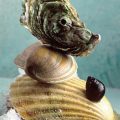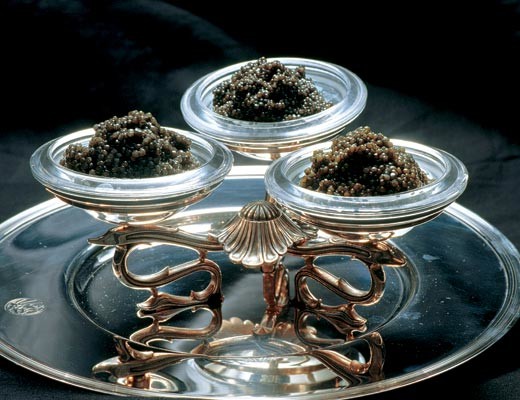 How much does black caviar cost? Caviar that Pushkin«встретил» гостей, проживая в столь неприглядной обстановке, и в его эпоху, и раньше было на Руси вдоволь. Хорошее свидетельство тому— воспоминания В.А. Гиляровского: «Чернелась в серебряных ведрах, в кольце прозрачного льда, стерляжья мелкая икра, высилась над краями горкой темная осетровая и крупная, зернышко к зернышку, белужья. Ароматная паюсная, мартовская, с Сальянских промыслов, пухла на серебряных блюдах; далее сухая мешочная — тонким ножом пополам каждая икринка режется— высилась, сохраняя форму мешков, а лучшая в мире паюсная икра с особым землистым ароматом, ачуевская-кучугур, стояла огромными глыбами на блюдах…» Тот же Гиляровский пишет о волжских бурлаках, которые предпочитали икре воблу, — «обрыдла» она им…Что же произошло со всем этим изобилием и великолепием после того, как в XX веке черной икре присвоили статус деликатеса мирового значения и она перешла в разряд наидефицитнейших продуктов? Люди старшего и среднего поколений, конечно же, помнят бумажные стаканчики с 30 г лакомства на донышке, которые можно было заполучить разве что в праздничных заказах при обязательном соседстве с печеньем «Привет» и плавлеными сырками «Дружба».Сегодняшняя ситуация с икрой, с одной стороны, в корне изменилась — она входит в ассортимент всех приличных магазинов, с другой — из-за чудовищных масштабов браконьерства в продаже практически нет настоящей черной икры. Поэтому понимающие толк и заботящиеся о своем реноме владельцы и шеф-повара дорогих ресторанов вынуждены постоянно находиться в поиске качественного продукта.Рыба без чешуиОсетровые, относящиеся к группе лучеперых, промежуточной между хрящевыми (акулами, скатами) и обычными костистыми рыбами, существовали еще 250 млн. лет назад. Они старше динозавров и млекопитающих и обладают рядом архаических черт строения: основа их скелета — упругая хорда, костные позвонки и наличие небольшого количества чешуи лишь у основания хвостового плавника. Поэтому по правилам еврейской кошерной кухни употребление черной икры и самих осетровых не допускается — раз нет чешуи, значит, это не рыба.Обитают осетровые в придонных слоях воды, они живут в соленой воде, но приходят в реки на нерест. Могут жить до 100 лет, достигая около 1,5 т веса. У этих необычных рыб больше хромосом, чем у человека, и они обладают высокими адаптивными способностями. Но несмотря на это, из-за постоянных экологических проблем и «перевыполнения планов по улову» их численность угрожающе сокращается с каждым годом.Всего в мире насчитывают 23 вида осетровых, но только 3 из них являются «поставщиками» икры — , осетр и севрюга. Самая крупная и наиболее редкая — белуга — достигает более 4 м в длину и может весить более тонны. Ее популяция за последние 20 лет ХХ века сократилась на 90%. Осетр обычно весит менее 200 кг и редко превышает 2 м длины, хотя были времена, когда гигантских осетров из Волги практически ежедневно доставляли к царскому столу, причем, как говорят, в серебряных ваннах. Самая распространенная из осетровых — севрюга — не превышает 1,5 м длины и чаще всего весит около 25 кг.Черную икру подразделяют не только по виду рыб, но и по размеру, цвету, вкусу, аромату. По вкусу больше всего ценится серебристо-серая белужья икра. У нее самые крупные по размеру икринки, утонченный вкус и практически полное отсутствие специфического запаха. Чуть мельче — темно-бронзовая осетровая, обладающая слегка ощутимым ароматом. У севрюжьей — икринки самые мелкие, черного цвета, с сильным специфическим вкусом и запахом.Знаменитую «золотую икру» получают от белуги-альбиноса, впрочем, особенными достоинствами, за исключением необыкновенного золотисто-янтарного цвета, она не обладает.
How much does black caviar cost? Caviar that Pushkin«встретил» гостей, проживая в столь неприглядной обстановке, и в его эпоху, и раньше было на Руси вдоволь. Хорошее свидетельство тому— воспоминания В.А. Гиляровского: «Чернелась в серебряных ведрах, в кольце прозрачного льда, стерляжья мелкая икра, высилась над краями горкой темная осетровая и крупная, зернышко к зернышку, белужья. Ароматная паюсная, мартовская, с Сальянских промыслов, пухла на серебряных блюдах; далее сухая мешочная — тонким ножом пополам каждая икринка режется— высилась, сохраняя форму мешков, а лучшая в мире паюсная икра с особым землистым ароматом, ачуевская-кучугур, стояла огромными глыбами на блюдах…» Тот же Гиляровский пишет о волжских бурлаках, которые предпочитали икре воблу, — «обрыдла» она им…Что же произошло со всем этим изобилием и великолепием после того, как в XX веке черной икре присвоили статус деликатеса мирового значения и она перешла в разряд наидефицитнейших продуктов? Люди старшего и среднего поколений, конечно же, помнят бумажные стаканчики с 30 г лакомства на донышке, которые можно было заполучить разве что в праздничных заказах при обязательном соседстве с печеньем «Привет» и плавлеными сырками «Дружба».Сегодняшняя ситуация с икрой, с одной стороны, в корне изменилась — она входит в ассортимент всех приличных магазинов, с другой — из-за чудовищных масштабов браконьерства в продаже практически нет настоящей черной икры. Поэтому понимающие толк и заботящиеся о своем реноме владельцы и шеф-повара дорогих ресторанов вынуждены постоянно находиться в поиске качественного продукта.Рыба без чешуиОсетровые, относящиеся к группе лучеперых, промежуточной между хрящевыми (акулами, скатами) и обычными костистыми рыбами, существовали еще 250 млн. лет назад. Они старше динозавров и млекопитающих и обладают рядом архаических черт строения: основа их скелета — упругая хорда, костные позвонки и наличие небольшого количества чешуи лишь у основания хвостового плавника. Поэтому по правилам еврейской кошерной кухни употребление черной икры и самих осетровых не допускается — раз нет чешуи, значит, это не рыба.Обитают осетровые в придонных слоях воды, они живут в соленой воде, но приходят в реки на нерест. Могут жить до 100 лет, достигая около 1,5 т веса. У этих необычных рыб больше хромосом, чем у человека, и они обладают высокими адаптивными способностями. Но несмотря на это, из-за постоянных экологических проблем и «перевыполнения планов по улову» их численность угрожающе сокращается с каждым годом.Всего в мире насчитывают 23 вида осетровых, но только 3 из них являются «поставщиками» икры — , осетр и севрюга. Самая крупная и наиболее редкая — белуга — достигает более 4 м в длину и может весить более тонны. Ее популяция за последние 20 лет ХХ века сократилась на 90%. Осетр обычно весит менее 200 кг и редко превышает 2 м длины, хотя были времена, когда гигантских осетров из Волги практически ежедневно доставляли к царскому столу, причем, как говорят, в серебряных ваннах. Самая распространенная из осетровых — севрюга — не превышает 1,5 м длины и чаще всего весит около 25 кг.Черную икру подразделяют не только по виду рыб, но и по размеру, цвету, вкусу, аромату. По вкусу больше всего ценится серебристо-серая белужья икра. У нее самые крупные по размеру икринки, утонченный вкус и практически полное отсутствие специфического запаха. Чуть мельче — темно-бронзовая осетровая, обладающая слегка ощутимым ароматом. У севрюжьей — икринки самые мелкие, черного цвета, с сильным специфическим вкусом и запахом.Знаменитую «золотую икру» получают от белуги-альбиноса, впрочем, особенными достоинствами, за исключением необыкновенного золотисто-янтарного цвета, она не обладает.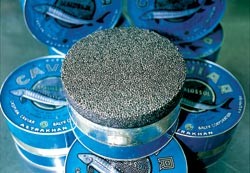 According to the processing method, black caviar is divided intogranular, pressed and yastyk. Granular is made from firm, elastic, uniform in size and color eggs. Pasteurized caviar is heated, sometimes with the addition of antiseptics, in a closed container it can be stored for about 8 months, and in an open one - only 1-2 days. Pressed - is made from the fattest stellate sturgeon grain or from a mixture of stellate sturgeon and sturgeon caviar. It can also be stored for no more than eight months. Yastyk is caviar that has not been cleaned from the film (yastyk), which makes a rather unpleasant impression on an unprepared person due to the abundance of foreign inclusions. Previously, in Russia, only one type of salt was traditionally used to make "granular snacks" - blue "grenade" from deep mines somewhere in the territory of the current Perm region. Today, unfortunately, for brine they simply use “Extra” salt in a ratio of 45 g of salt per 1 liter of water. By the way, to find out about the level of salt in caviar, which determines its quality, true connoisseurs are offered a small silver ball on a very thin chain in expensive shops, such as Caviar House in Cannes. The ball is lowered onto the caviar, if it immediately sinks in, the ratio of fats and salt is ideal, if it lingers on the surface, the quality of the delicacy is questionable.
According to the processing method, black caviar is divided intogranular, pressed and yastyk. Granular is made from firm, elastic, uniform in size and color eggs. Pasteurized caviar is heated, sometimes with the addition of antiseptics, in a closed container it can be stored for about 8 months, and in an open one - only 1-2 days. Pressed - is made from the fattest stellate sturgeon grain or from a mixture of stellate sturgeon and sturgeon caviar. It can also be stored for no more than eight months. Yastyk is caviar that has not been cleaned from the film (yastyk), which makes a rather unpleasant impression on an unprepared person due to the abundance of foreign inclusions. Previously, in Russia, only one type of salt was traditionally used to make "granular snacks" - blue "grenade" from deep mines somewhere in the territory of the current Perm region. Today, unfortunately, for brine they simply use “Extra” salt in a ratio of 45 g of salt per 1 liter of water. By the way, to find out about the level of salt in caviar, which determines its quality, true connoisseurs are offered a small silver ball on a very thin chain in expensive shops, such as Caviar House in Cannes. The ball is lowered onto the caviar, if it immediately sinks in, the ratio of fats and salt is ideal, if it lingers on the surface, the quality of the delicacy is questionable.
How to determine the quality of caviar and recognize a fake?
PackagingThe first source of information about the product isits packaging. Legal caviar is sold in retail in 90 g tins and in 28 g, 56 g and 113 g glass jars with tin lids of different colors. Beluga caviar is traditionally packaged in jars with blue lids, sturgeon caviar in yellow lids, and stellate sturgeon in red lids. Canned caviar, not preserved caviar, is sold in factory-made 500 g and 1,800 g washers at markets. They are intended for quick transportation from the fish factory to the cannery, where they are packaged in cans that allow the product to be stored for a long time. At room temperature, caviar in such temporary packaging can last no more than a day: numerous light fats in its composition quickly oxidize, forming toxic compounds. Since caviar products are made exclusively from fresh raw materials and no technological method of freezing is provided for them, they are manufactured by enterprises located on the coast. Thus, all the famous Russian black caviar is produced with the permission of the state at only a few factories in Astrakhan, Volgograd and Kalmykia. If the packaging says that it is “made” at enterprises located in Moscow, the Moscow region or St. Petersburg, rest assured that this is a counterfeit with violated technological parameters. Such a delicacy is at best made from frozen raw materials, and at worst - diluted with artificial caviar made at a gelatin plant. PriceAnother important source of information about the delicacy can be the price, which depends not so much on the manufacturer as on the fish species. Caviar from beluga, listed in the Red Book, is most highly valued: one kilogram of such products in Russia can cost up to 620 euros, abroad - from 4 to 7 thousand euros. By the way, Beluga caviar cannot be officially sold freely: commercial fishing of this fish is prohibited in Russia. The second place in terms of prevalence and price is occupied by Russian sturgeon caviar: its annual production volume is, according to experts, 180 tons per year. 1 kg of the product prepared according to US standards and technology costs about 1,200 dollars, and on the Russian market it is valued at 230 euros (in a supermarket - 450 euros). In Russian markets close to the production areas, a liter of black caviar can be bought for 1 thousand rubles. The largest amount - 230 tons per year - is stellate sturgeon caviar. The cost of 1 kg of the delicacy both at market traders and in chain stores is on average 200 euros.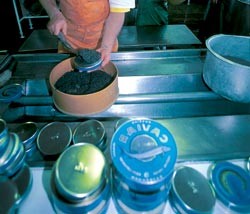 Organic indicatorsOf course, the type of fish,The way the caviar is processed and other factors affect the appearance of the final product. However, there are some common signs of its quality. Mature caviar, i.e. light and large, obtained from fish that have already come to the river to spawn, is of the highest quality. Poachers usually have access to young, dark and small caviar caught in the sea. Another indicator of freshness is the hardness and dryness of the eggs, their elasticity and “distinctiveness” (easy separation from each other). To mask the unpleasant features of stale products or to increase their weight, strong cold tea, vegetable oil and other liquids are sometimes mixed into black granular caviar of artisanal production. In this case, the eggs swell, lose strength, wrinkle and burst. Sediment (viscous liquid on the bottom and walls of the container) is a sign of poor quality goods. To detect it, put some caviar on a plate and blow on it: good caviar has eggs that roll easily without sticking to the dish. Just as there is no such thing as second-fresh sturgeon, this black delicacy spoils once and for all. The main insidiousness of stale caviar, unlike fish, is not at all in its suspicious smell. As a rule, it does not exist. A stale product is given away by its characteristic taste qualities. Violation of the recipe composition of black caviar can be achieved by adding additional salt (its optimal content in the product is 4.6%). So, oversalting of the delicacy is usually explained by the fact that salt is used to mask the product's shortcomings. The situation is more complicated with boric acid, which is indistinguishable in taste and is added to poached caviar as an antiseptic. The main differences between artificial caviar are: 1) natural caviar has a faint smell of fish, while artificial caviar is flavored with herring brine, which has a correspondingly sharp smell; 2) sturgeon caviar bursts and splashes when crushed in the mouth, artificial caviar, as is typical of gelatin, sticks to the teeth; 3) in natural caviar, the embryonic vesicle ("eye") is often visible to the naked eye. However, in the case of partial dilution of natural caviar with artificial (up to 15-20%), it is, alas, almost impossible to recognize counterfeiting by organoleptic indicators: here one cannot do without instrumental methods of examination.
Organic indicatorsOf course, the type of fish,The way the caviar is processed and other factors affect the appearance of the final product. However, there are some common signs of its quality. Mature caviar, i.e. light and large, obtained from fish that have already come to the river to spawn, is of the highest quality. Poachers usually have access to young, dark and small caviar caught in the sea. Another indicator of freshness is the hardness and dryness of the eggs, their elasticity and “distinctiveness” (easy separation from each other). To mask the unpleasant features of stale products or to increase their weight, strong cold tea, vegetable oil and other liquids are sometimes mixed into black granular caviar of artisanal production. In this case, the eggs swell, lose strength, wrinkle and burst. Sediment (viscous liquid on the bottom and walls of the container) is a sign of poor quality goods. To detect it, put some caviar on a plate and blow on it: good caviar has eggs that roll easily without sticking to the dish. Just as there is no such thing as second-fresh sturgeon, this black delicacy spoils once and for all. The main insidiousness of stale caviar, unlike fish, is not at all in its suspicious smell. As a rule, it does not exist. A stale product is given away by its characteristic taste qualities. Violation of the recipe composition of black caviar can be achieved by adding additional salt (its optimal content in the product is 4.6%). So, oversalting of the delicacy is usually explained by the fact that salt is used to mask the product's shortcomings. The situation is more complicated with boric acid, which is indistinguishable in taste and is added to poached caviar as an antiseptic. The main differences between artificial caviar are: 1) natural caviar has a faint smell of fish, while artificial caviar is flavored with herring brine, which has a correspondingly sharp smell; 2) sturgeon caviar bursts and splashes when crushed in the mouth, artificial caviar, as is typical of gelatin, sticks to the teeth; 3) in natural caviar, the embryonic vesicle ("eye") is often visible to the naked eye. However, in the case of partial dilution of natural caviar with artificial (up to 15-20%), it is, alas, almost impossible to recognize counterfeiting by organoleptic indicators: here one cannot do without instrumental methods of examination.
Sparkling "Chibis"
Since caviar became popular in Soviet timesa kind of symbol of well-being, a task of national importance arose - to saturate the market with this delicacy, and at least "man-made". Thus, in 1960, the world's first artificial caviar was obtained in the USSR at the Chibis installation. It turned out to be expensive, tasteless, and so difficult to make that production could only be established in Moscow, Leningrad, Kyiv and the Baltic capitals. It was at this time that the famous joke arose about Vasya from the plant, who was instructed by the foreman to pick out the eyes of salted sprats so that the foreign delegation would be shocked by the sight of an ordinary Soviet person snacking on a sandwich with "caviar" at work. In the 1970-1980s, continuous work was underway in Gorky to improve the technology, which led to the creation of a compact installation producing a delicacy from milk, gelatin and various additives. The quality of the product was so high that most people who tried a sandwich with pseudo-black caviar did not notice the catch. Although this fact, to be fair, can be explained by the fact that they rarely tried real caviar and, by and large, had nothing to compare it with. They only got to "indulge" in it during elections - this is how people were attracted to polling stations, and also in the buffets of the Bolshoi Theater or the Kremlin Palace of Congresses.
Joyless perspective
International Organization for Conservation of Nature"tracked" the amount of caviar on the world market, as a result of which it turned out that it significantly differs from the officially declared quotas by more than 10 times. That is, for every legal can of delicacy, there are now, according to various estimates, from 13 to 20 poached ones. The stinking smell of rotting sturgeon remains hangs around the places chosen for illegal fishing. When catching fish, poachers throw the males mutilated by hooks back into the water, and rip open the bellies of the females, take the caviar, salt them "anyhow" and leave with their catch, leaving the giant carcasses lying and rotting, which are too much trouble. It is not surprising that sturgeon populations, which are also very sensitive to water pollution, are rapidly declining.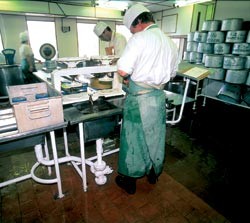 About 15 years ago in France, Italy and the USAbegan to create sturgeon farms. Today they exist in 20 different countries. In these farms they breed "early maturing" sturgeons and obtain black caviar from them using a new technology, without killing the fish. But while such large-scale poaching flourishes, the chances of sturgeons to leave the pages of the Red Book are small, and the day is not far off when the famous poster with the slogan "Life is good" written in black will no longer make us smile.
About 15 years ago in France, Italy and the USAbegan to create sturgeon farms. Today they exist in 20 different countries. In these farms they breed "early maturing" sturgeons and obtain black caviar from them using a new technology, without killing the fish. But while such large-scale poaching flourishes, the chances of sturgeons to leave the pages of the Red Book are small, and the day is not far off when the famous poster with the slogan "Life is good" written in black will no longer make us smile.
Forced measures
According to official representativesAccording to the International Organization for Trade in Endangered Species of Flora and Fauna (CITES), many subspecies of the sturgeon family are under threat of complete extinction. Thus, in 2005, compared to mid-2004, the number of fish in the Caspian Sea decreased by more than a third. And it is in the Caspian Sea that 90% of all black caviar entering the world markets is caught. The CITES organization, which operates under the auspices of the UN, has repeatedly called on caviar exporters to be conscientious, thus trying to motivate them to fight poaching. However, these half-measures have had no effect. Therefore, in January 2006, the Secretariat of the Geneva Convention CITES announced a temporary ban on the trade in sturgeon and black caviar everywhere. This taboo does not apply to enterprises breeding sturgeon in captivity. This state of affairs will continue until the producing countries provide objective information on the state of the sturgeon population. The size of the sturgeon export quotas is proposed to be established by the producers themselves, after which they must be approved. However, to do this, they must prove that the catch and export quotas they propose reflect the current state of the sturgeon population. At the preliminary meeting of the Caspian Sea Marine Resources Commission, held in Astana, the sturgeon and caviar exporting countries decided to reduce the catch by 23%, that is, to reduce the sturgeon catch quotas: for Russia by 30.5% - to 258 tons, for Iran by 16% - to 500 tons, for Kazakhstan by 12% - to 195 tons, for Azerbaijan by 8% - to 92 tons; and for caviar production: for Russia by 81% - up to 3.9 tons, for Iran by 15% - up to 51 tons, for Kazakhstan by 17% - up to 13.2 tons and for Azerbaijan by 3% - up to 6.5 tons.






